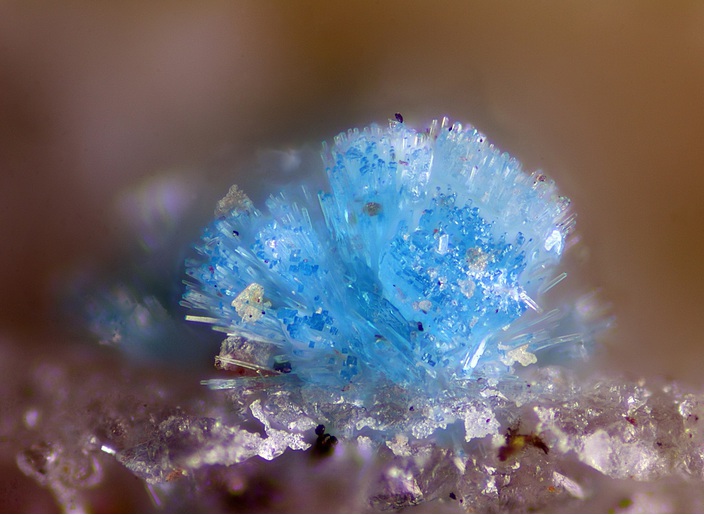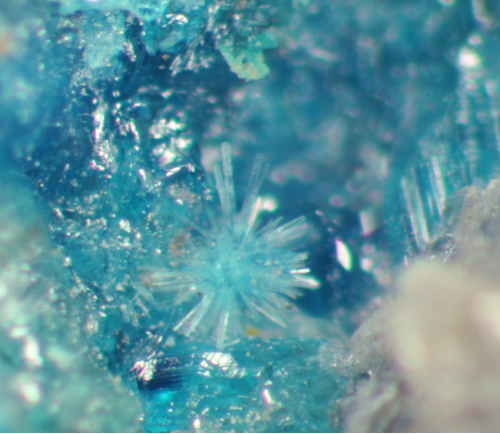Ashburtonite
A valid IMA mineral species
This page is currently not sponsored. Click here to sponsor this page.
About Ashburtonite
Formula:
Pb4Cu4(Si4O12)(HCO3)4(OH)3Cl · H2O
Colour:
Blue
Lustre:
Vitreous
Specific Gravity:
4.69 (Calculated)
Crystal System:
Tetragonal
Name:
Named in 1991 by Joel Denison Grice, Ernest (Ernie) Henry Nickel, and Robert A. Gault for the type locality near the Ashburton Downs pastoral lease and homestead, Western Australia, Australia.
Unique Identifiers
Mindat ID:
388
Long-form identifier:
mindat:1:1:388:1
GUID
(UUID V4):
(UUID V4):
1b222b53-700b-4550-be05-e95556431462
IMA Classification of Ashburtonite
Approved
IMA Formula:
HCu4Pb4Si4O12(HCO3)4(OH)4Cl
First published:
1991
Classification of Ashburtonite
9.CF.05
9 : SILICATES (Germanates)
C : Cyclosilicates
F : [Si4O12]8- 4-membered single rings, with insular complex anions
9 : SILICATES (Germanates)
C : Cyclosilicates
F : [Si4O12]8- 4-membered single rings, with insular complex anions
78.4.2.1
78 : Unclassified Silicates
4 :
78 : Unclassified Silicates
4 :
17.4.13
17 : Silicates Containing other Anions
4 : Silicates with carbonates
17 : Silicates Containing other Anions
4 : Silicates with carbonates
Mineral Symbols
As of 2021 there are now IMA–CNMNC approved mineral symbols (abbreviations) for each mineral species, useful for tables and diagrams.
| Symbol | Source | Reference |
|---|---|---|
| Ahb | IMA–CNMNC | Warr, L.N. (2021). IMA–CNMNC approved mineral symbols. Mineralogical Magazine, 85(3), 291-320. doi:10.1180/mgm.2021.43 |
Pronunciation of Ashburtonite
Pronunciation:
| Play | Recorded by | Country |
|---|---|---|
| Jolyon Ralph | United Kingdom |
Physical Properties of Ashburtonite
Vitreous
Transparency:
Transparent
Colour:
Blue
Streak:
Pale blue
Tenacity:
Very brittle
Cleavage:
None Observed
Fracture:
Conchoidal
Density:
4.69 g/cm3 (Calculated)
Optical Data of Ashburtonite
Type:
Uniaxial (+)
RI values:
nω = 1.786(3) nε = 1.800(4)
Max Birefringence:
δ = 0.014

Image shows birefringence interference colour range (at 30µm thickness)
and does not take into account mineral colouration.
and does not take into account mineral colouration.
Surface Relief:
Very High
Chemistry of Ashburtonite
Mindat Formula:
Pb4Cu4(Si4O12)(HCO3)4(OH)3Cl · H2O
Crystallography of Ashburtonite
Crystal System:
Tetragonal
Cell Parameters:
a = 14.234(7) Å, c = 6.103(5) Å
Ratio:
a:c = 1 : 0.429
Unit Cell V:
1,236.51 ų (Calculated from Unit Cell)
Z:
2
Comment:
I4/m, I4 and I4
Crystal Structure
Load
Unit Cell | Unit Cell Packed
2x2x2 | 3x3x3 | 4x4x4
Unit Cell | Unit Cell Packed
2x2x2 | 3x3x3 | 4x4x4
Show
Big Balls | Small Balls | Just Balls | Spacefill
Polyhedra Off | Si Polyhedra | All Polyhedra
Remove metal-metal sticks
Big Balls | Small Balls | Just Balls | Spacefill
Polyhedra Off | Si Polyhedra | All Polyhedra
Remove metal-metal sticks
Display Options
Black Background | White Background
Perspective On | Perspective Off
2D | Stereo | Red-Blue | Red-Cyan
Black Background | White Background
Perspective On | Perspective Off
2D | Stereo | Red-Blue | Red-Cyan
View
CIF File Best | x | y | z | a | b | c
CIF File Best | x | y | z | a | b | c
Rotation
Stop | Start
Stop | Start
Labels
Console Off | On | Grey | Yellow
Console Off | On | Grey | Yellow
Data courtesy of the American Mineralogist Crystal Structure Database. Click on an AMCSD ID to view structure
| ID | Species | Reference | Link | Year | Locality | Pressure (GPa) | Temp (K) |
|---|---|---|---|---|---|---|---|
| 0001412 | Ashburtonite | Grice J D, Nickel E H, Gault R A (1991) Ashburtonite, a new bicarbonate-silicate mineral from Ashburton Downs, Western Australia: Description and structure determination American Mineralogist 76 1701-1707 |  | 1991 | 0 | 293 |
CIF Raw Data - click here to close
X-Ray Powder Diffraction
Powder Diffraction Data:
| d-spacing | Intensity |
|---|---|
| 10.2 Å | (100) |
| 4.495 Å | (100) |
| 3.333 Å | (100) |
| 3.013 Å | (90) |
| 5.644 Å | (70) |
| 2.611 Å | (50) |
| 2.805 Å | (30) |
Geological Environment
Paragenetic Mode(s):
| Paragenetic Mode | Earliest Age (Ga) |
|---|---|
| Near-surface Processes | |
| 23 : Subaerial aqueous alteration by non-redox-sensitive fluids (see also #47) |
Type Occurrence of Ashburtonite
General Appearance of Type Material:
Clusters of clear blue, prismatic crystals up to 0.4 mm long.
Place of Conservation of Type Material:
Collection of the Canadian Museum of Nature under catalog no. CMN 58391 and in the Museum of Victoria, Melbourne, under catalog no. M40712.
Geological Setting of Type Material:
An assemblage of secondary minerals in a weathered shear zone that cuts a series of shales and graywackes.
Associated Minerals at Type Locality:
Reference:
Grice, J. D., Nickel, E. H., Gault, R. A. (1991): Ashburtonite, a new bicarbonate-silicate mineral from Ashburton Downs, Western Australia: Description and structure determination: American Mineralogist: 76, 1701-1707.
Synonyms of Ashburtonite
Other Language Names for Ashburtonite
Common Associates
Associated Minerals Based on Photo Data:
| 6 photos of Ashburtonite associated with Caledonite | Pb5Cu2(SO4)3(CO3)(OH)6 |
| 4 photos of Ashburtonite associated with Botallackite | Cu2(OH)3Cl |
| 3 photos of Ashburtonite associated with Cerussite | PbCO3 |
| 1 photo of Ashburtonite associated with Diaboleite | Pb2CuCl2(OH)4 |
| 1 photo of Ashburtonite associated with Clinoatacamite | Cu2(OH)3Cl |
| 1 photo of Ashburtonite associated with Quartz | SiO2 |
Related Minerals - Strunz-mindat Grouping
| 9.CF. | Bobmeyerite | Pb4(Al3Cu)(Si4O12)(S0.5Si0.5O4)(OH)7Cl(H2O)3 |
| 9.CF.10 | Kainosite-(Y) | Ca2(Y,Ce)2(Si4O12)(CO3) · H2O |
| 9.CF.15 | Clinophosinaite | Na12(Ca,Sr)4(Si4O12)(PO4)4 |
| 9.CF.15 | Phosinaite-(Ce) | Na13Ca2(Ce,La,Th,Nd,Pr)(Si4O12)(PO4)4 |
| 9.CF.20 | Strakhovite | NaBa3Mn2+2Mn3+2Si6O19(OH)3 |
| 9.CF.25 | Cerchiaraite-(Mn) | Ba4Mn3+4(Si4O12)O2(OH)4Cl2[Si2O3(OH)4] |
| 9.CF.25 | Cerchiaraite-(Al) | Ba4Al4O3(OH)3(Si4O12)[Si2O3(OH)4]Cl |
| 9.CF.25 | Cerchiaraite-(Fe) | Ba4Fe3+4O3(OH)3(Si4O12)[Si2O3(OH)4]Cl |
Other Information
Notes:
Decomposes rapidly in concentrated HCl and slowly in 0.2 M HCl, 1:1 HNO3, and concentrated H2SO4.
Health Risks:
No information on health risks for this material has been entered into the database. You should always treat mineral specimens with care.
Internet Links for Ashburtonite
mindat.org URL:
https://www.mindat.org/min-388.html
Please feel free to link to this page.
Please feel free to link to this page.
Search Engines:
External Links:
Mineral Dealers:
References for Ashburtonite
Reference List:
Grice, Joel D., Nickel, Ernest H., Gault, Robert A. (1991) Ashburtonite, a new bicarbonate-silicate mineral from Ashburton Downs, Western Australia: Description and structure determination. American Mineralogist, 76 (9-10) 1701-1707
Localities for Ashburtonite
Locality List
 - This locality has map coordinates listed.
- This locality has map coordinates listed.
 - This locality has estimated coordinates.
ⓘ - Click for references and further information on this occurrence.
? - Indicates mineral may be doubtful at this locality.
- This locality has estimated coordinates.
ⓘ - Click for references and further information on this occurrence.
? - Indicates mineral may be doubtful at this locality.
 - Good crystals or important locality for species.
- Good crystals or important locality for species.
 - World class for species or very significant.
(TL) - Type Locality for a valid mineral species.
(FRL) - First Recorded Locality for everything else (eg varieties).
- World class for species or very significant.
(TL) - Type Locality for a valid mineral species.
(FRL) - First Recorded Locality for everything else (eg varieties).
All localities listed without proper references should be considered as questionable.
Australia | |
| Nickel et al. (1993) |
| Amer.Min. (1991) | |
USA | |
| Collected by and in the collection of ... +1 other reference |
| PXRD analyzed by Tony Kampf. +1 other reference |
Quick NavTopAbout AshburtoniteUnique IdentifiersIMA Classification Classification Mineral SymbolsPronunciation Physical Properties Optical Data Chemistry Crystallography Crystal StructureX-Ray Powder DiffractionGeological EnvironmentType Occurrence SynonymsOther LanguagesCommon AssociatesStrunz-MindatOther InformationInternet Links References Localities Locality List






 symbol to view information about a locality.
The
symbol to view information about a locality.
The 



Rowley Mine, Theba, Painted Rock Mining District, Painted Rock Mountains, Maricopa County, Arizona, USA